 W
WAcrochordus arafurae is an aquatic snake species found in northern Australia and New Guinea. No subspecies are currently recognized.
 W
WAcrochordus granulatus is a snake species found from India through Southeast Asia to the Solomon Islands. It is known as the little file snake, marine file snake, and little wart snake. It is completely aquatic and almost helpless on land. No subspecies are currently recognized.
 W
WThe amethystine python, also known as the scrub python or sanca permata locally, is a species of non-venomous snake in the family Pythonidae. The species is found in Indonesia, Papua New Guinea, and Australia. Popular among reptile enthusiasts, and noted for its coloration and size, it is one of the six largest snakes in the world, as measured either by length or weight, and is the largest native snake in Australia and Papua New Guinea.
 W
WApodora papuana is a species of python, commonly known as the Papuan python, Irian python or Papuan olive python. It is found in New Guinea. It is the only species in the genus Apodora. No subspecies are currently recognized.
 W
WThe blue-lipped sea krait, blue-banded sea krait, or common sea krait is a species of venomous sea snake in the subfamily Laticaudinae, family Elapidae. It is found in the Indian and Western Pacific Oceans.
 W
WThe brown tree snake, also known as the brown catsnake, is an arboreal rear-fanged colubrid snake native to eastern and northern coastal Australia, eastern Indonesia, Papua New Guinea, and many islands in northwestern Melanesia. This snake is infamous for being an invasive species responsible for extirpating the majority of the native bird population in Guam. It is also one of the very few colubrids found in Australia, where elapids are more common.
 W
WCandoia aspera, known commonly as the viper boa or New Guinea ground boa, is a species of snake in the family Boidae. As its common name suggests, it is found in New Guinea. They are a terrestrial species, living in the undergrowth. They are smaller than some other members of the Boidae family. Viper boas grow to 2 to 3 feet in length. They are known to be primarily nocturnal. Viper boas are known to be slightly more aggressive than other Candoia. In recent years they've become increasingly scarce in the pet industry, due to restrictions on import/export trading. Though they were more common in the past, there is still very little known about them, in particular their behaviour in the wild. For example; Their lifespan is still undetermined. It got the nickname viper boa from its appearance. They look extremely similar to the elapid species Acanthophis laevis, more commonly known as the "Papuan death adder." The death adder itself only resembles a viper, but is actually an elapid. However, because of the resemblance to the highly venomous death adder, many are killed out of fear although they are harmless.
 W
WCandoia carinata, known commonly as the Pacific ground boa or the Pacific keel-scaled boa, is a species of snake in the family Boidae.
 W
WThe coastal taipan, or common taipan, is a species of highly venomous snake in the family Elapidae. Described by Wilhelm Peters in 1867, the species is native to the coastal regions of northern and eastern Australia and the island of New Guinea. The second longest venomous snake in Australia, the coastal taipan averages around 2 m (6.6 ft) long, with the longest specimens reaching 2.9 m (9.5 ft) in length. It has light olive or reddish-brown upperparts, with paler underparts. The snake is considered to be a least-concern species according to the International Union for Conservation of Nature (IUCN).
 W
WD'Albertis' python, also known commonly as D'Albert's water python or the northern white-lipped python, is a species of python, a non-venomous snake in the family Pythonidae. The species is endemic to New Guinea. There are no subspecies that are recognized as being valid.
 W
WDendrelaphis calligastra, also called green tree snake and northern green tree snake is a colubrid snake native to Indonesia, Papua New Guinea and Australia. It is a slender, large-eyed, nonvenomous, diurnal snake, which grows up to 1.2 m in length and is greenish, brown, or greyish above with a cream or yellow belly.
 W
WDendrelaphis punctulatus, also known commonly as the Australian tree snake, the common tree snake, and the green tree snake, is a species of slender, large-eyed, diurnal, non-venomous snake in the family Colubridae. The species is native to many parts of Australia, especially in the northern and eastern coastal areas, and to Papua New Guinea.
 W
WThe eastern brown snake, often referred to as the common brown snake, is a species of highly venomous snake in the family Elapidae. The species is native to eastern and central Australia and southern New Guinea. It was first described by André Marie Constant Duméril, Gabriel Bibron, and Auguste Duméril in 1854. The adult eastern brown snake has a slender build and can grow to 2 m (7 ft) in length. The colour of its surface ranges from pale brown to black, while its underside is pale cream-yellow, often with orange or grey splotches. The eastern brown snake is found in most habitats except dense forests. They are found often in farmland and on the outskirts of urban areas, as such places are populated by their main prey, the house mouse. The species is oviparous. The International Union for Conservation of Nature (IUCN) classifies the snake as a least-concern species, though its status in New Guinea is unclear.
 W
WThe green tree python is a species of snake in the family Pythonidae. The species is native to New Guinea, some islands in Indonesia, and the Cape York Peninsula in Australia. First described by Hermann Schlegel in 1872, it was known for many years as Chondropython viridis. As its common name suggests, it is a bright green snake that can reach a total length of 2 m (6.6 ft) and a weight of 1.6 kg (3.5 lb), with females slightly larger and heavier than males. Living generally in trees, the green tree python mainly hunts and eats small reptiles and mammals. It is a popular pet, and numbers in the wild have suffered with large-scale smuggling of wild-caught green tree pythons in Indonesia. Despite this, the green tree python is rated as least concern on the IUCN Red List of endangered species.
 W
WHydrophis peronii, commonly known as the horned sea snake, Peron's sea snake, and the spiny-headed seasnake, is a species of venomous snake in the subfamily Hydrophiinae of the family Elapidae. The species is endemic to the western tropical Pacific Ocean. It is the only sea snake with spines on the head. Like all other members of the family Elapidae, it is venomous. It is sometimes placed in its own genus Acalyptophis.
 W
WLiasis mackloti is a species of python, a nonvenomous snake in the family Pythonidae. The species is endemic to Indonesia, East Timor, Papua New Guinea, and coastal northern Australia. Three subspecies are currently recognized, including the nominate subspecies described here.
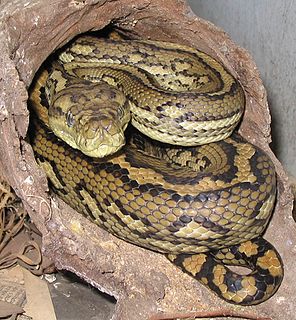 W
WMorelia spilota, commonly referred to as the carpet python, is a large snake of the family Pythonidae found in Australia, New Guinea, Bismarck Archipelago, and the northern Solomon Islands. Many subspecies are described: ITIS lists six, the Reptile Database six, and the IUCN eight.
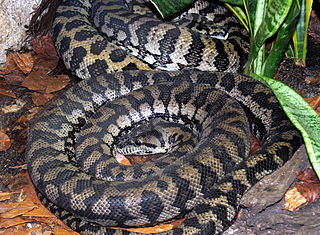 W
WMorelia spilota variegata, commonly known as Torresian carpet python, Darwin carpet python or northwestern carpet python, is a subspecies of python found in New Guinea and Australia, smaller than the nominate subspecies Morelia spilota spilota and has a more restricted geographic range.
 W
WThe northern death adder is a species of venomous snake in the family Elapidae.
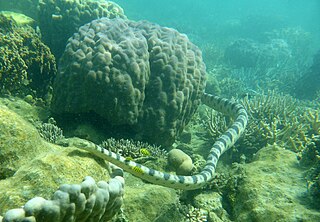 W
WThe olive-headed sea snake, also known as the greater sea snake, is a species of venomous sea snake in the family Elapidae.
 W
WSimalia boeleni is a species of python, a nonvenomous snake in the family Pythonidae. The species is endemic to the mountains of New Guinea. No subspecies are currently recognized.
 W
WThe smooth-scaled death adder is a species of venomous snake in the family Elapidae. The species is endemic to Southeast Asia and Oceania.
 W
WThe spotted python, eastern small-blotched python, or eastern children's python is a python species found in northern Australia and New Guinea. It is a popular pet among Australian reptile enthusiasts and other reptile enthusiasts abroad due to its small size and even temperament. No subspecies were originally recognized. However, two subspecies are currently recognized as of 2020; A. maculosa maculosa and A maculosa peninsularis. The spotted pythons of New Guinea were reclassified as their own unique species, A. papuensis or the Papuan spotted python, in the same study that discovered the two mainland subspecies.
 W
WStokes's sea snake is a large species of sea snake in the family Elapidae. It is sometimes placed in its own genus Astrotia. The species is endemic to tropical Indo-Pacific oceanic waters.
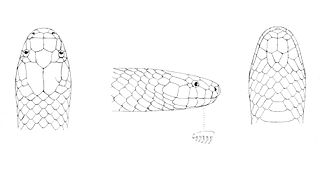 W
WToxicocalamus loriae, also known commonly as the Loria forest snake, is a species of venomous snake in the family Elapidae. The species is native to New Guinea.
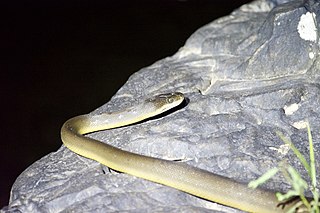 W
WThe water python is a non-venomous python species found in Australia and Papua New Guinea. No subspecies are currently recognized.
 W
WThe yellow-lipped sea krait, also known as the banded sea krait or colubrine sea krait, is a species of venomous sea snake found in tropical Indo-Pacific oceanic waters. The snake has distinctive black stripes and a yellow snout, with a paddle-like tail for use in swimming.